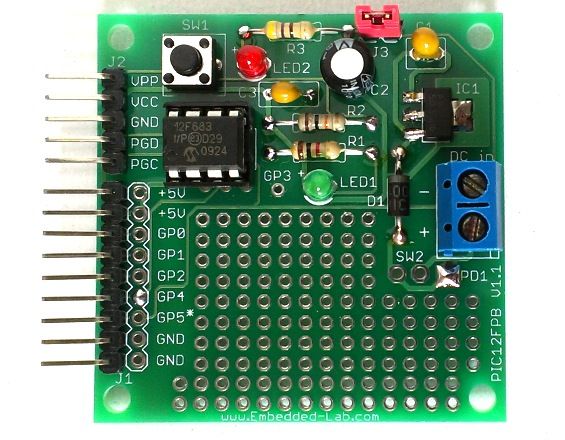The 12F series of PIC microcontrollers are handy little 8-pin devices designed for small embedded applications that do not require too many I/O resources, and where small size is advantageous. These applications include a wide range of everyday products such as hair dryers, electric toothbrushes, rice cookers, vacuum cleaners, coffee makers, and blenders.
Despite their small size, the PIC12F series microcontrollers offer interesting features including wide operating voltage, internal programmable oscillator, 4 channels of 10-bit ADC, on-board EEPROM memory, on-chip voltage reference, multiple communication peripherals (UART, SPI, and I2C), PWM, and more. This is a revised version of the previous PIC12F development board and is designed for fast and easy development of standalone applications using PIC12F microcontrollers. It features an on-board regulated +5V power supply, header connectors to access I/O pins, an ICSP header for programming, a reset circuit, and a small prototyping area for placing additional components.
Key features:
- 2-pin terminal block for DC input (6-12 V DC)
- AMS1117-5.0V regulator on board
- Tact switch connected to RA3 I/O pin, which is input only. It can be used as reset if MCLR is enabled. It can also be used as an user input if MCLR is disabled.
- Header connector for ICSP programming using chipKIT2/3.
- Headers to access I/O pins and power supply pins (Vcc = +5V, and GND).
- Small prototyping area for connecting additional circuit. The regulated +5V power supply for the additional circuit can be derived from the Vcc header pins.
- Two plated-through-holes for connecting an external ON/OFF switch.
- Power supply indicator LED (LED1)
- User output LED (LED2) connected to GP5 pin through a jumper (J3).
For circuit diagram and other details, visit the original article that was posted before.
The PIC12F breakout board is available on Tindie (Buying Link) for $10.99 as kit. Note that the kit doesn’t contain the microcontroller.
For more detail: Revised version of the PIC12F microcontrollers breakout board

